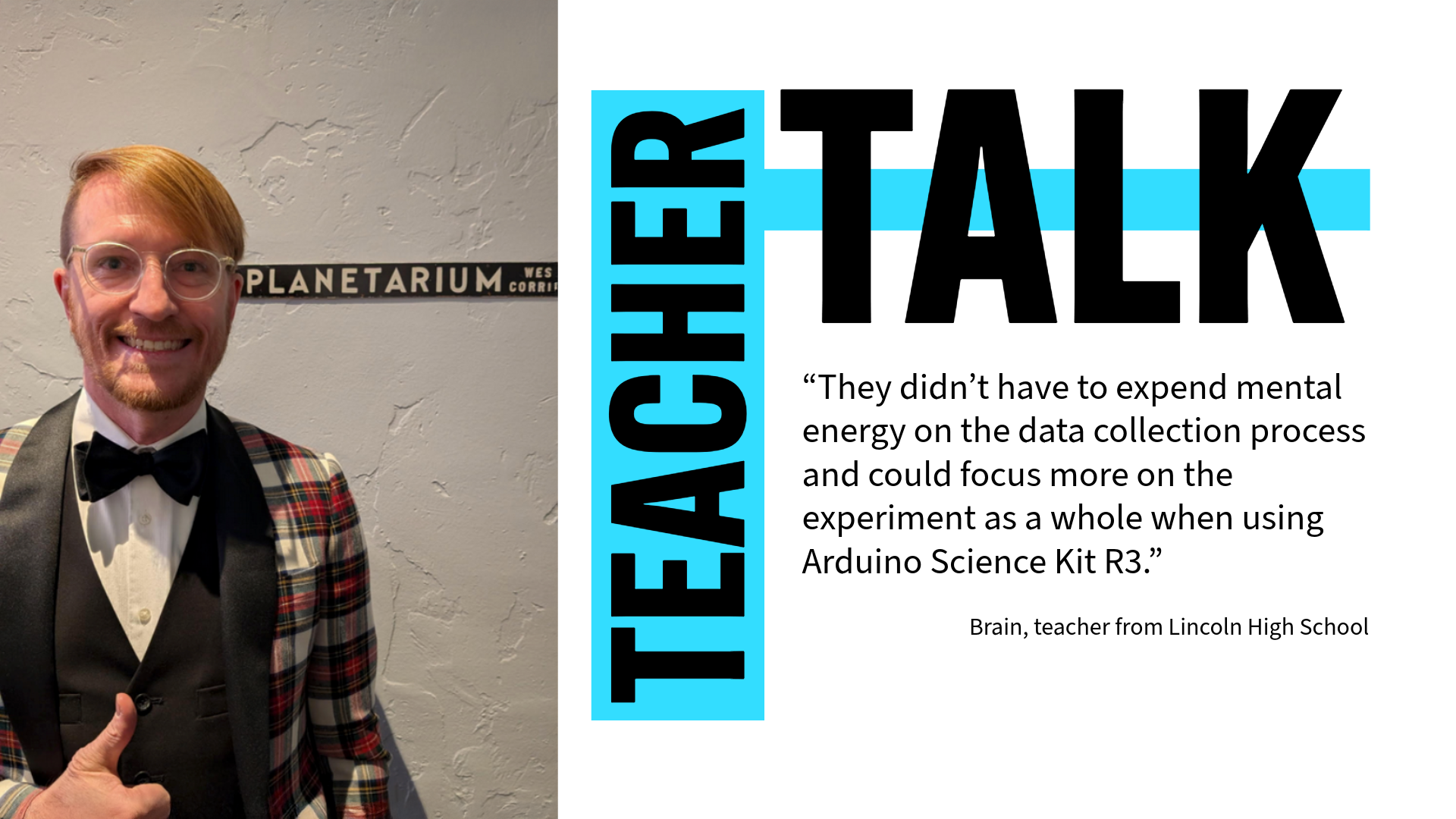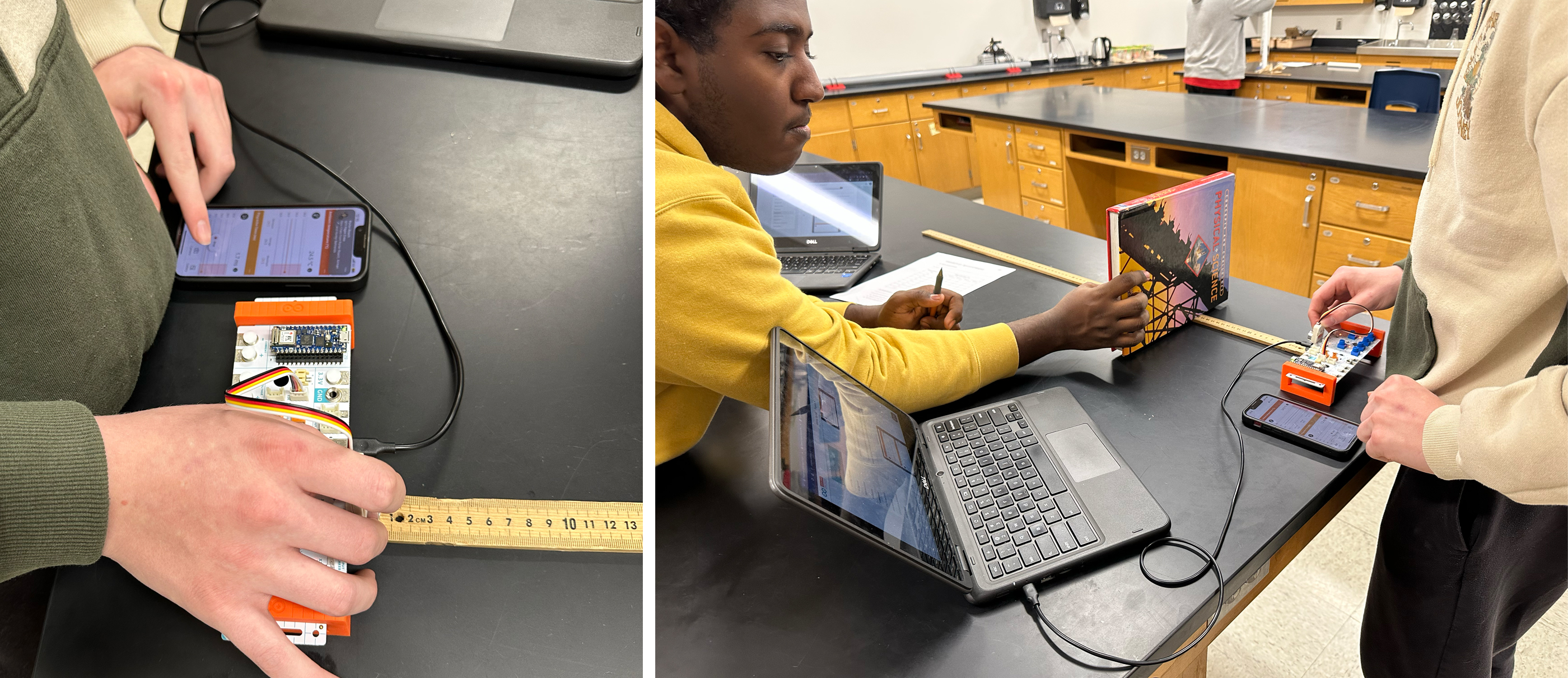Meet Brian, a Physics Teacher Turning Theory into Action with Arduino Science Kit R3

At Lincoln High School in Lincoln, Nebraska, Brian brings a unique blend of scientific expertise and innovative teaching to his physics classroom. His background spans astronautical engineering, astrophysics, and organic chemistry, along with years spent in research labs.Now, in the classroom, Brian now focuses on hands-on, exploratory learning that empowers students to dive deep into scientific concepts. Recently, he integrated the Arduino Science Kit R3 into his curriculum, merging traditional experiments with modern technology to spark curiosity and deepen understanding. In this interview, Brian shares his experience using the kit, the impact it’s had on his students, and why he believes tech-enhanced tools like this are shaping the future of STEM education.
Arduino: Can you tell us a bit about yourself, your teaching background, and your classroom environment?
Brian: I have been a high school teacher for 7 years now. My background is in astronautical engineering, astrophysics, and organic chemistry, and I spent many years in various labs before I found my educational calling. I like to keep my physics classroom environment ever-evolving. There is a lot of background knowledge and foundational material that students need to have a firm footing in their understanding of concepts, so I am always looking for new ways to have them get their hands dirty and really explore ideas. Lots of labs, drones, 3D printing, and now the Arduino Science Kit R3!
Arduino: What made you interested in trying the Science Kit R3 with your students?
Brian: I have used Arduino on personal tinkering projects outside the classroom, and see it as an engaging, accessible means of putting theory into practice. When I became aware that there was a Science Kit seemingly tailor-made for the types of lab experiments my physics students conduct, I couldn’t wait to test it out.
“The Science Kit R3 and the corresponding Arduino Explore Physics projects aligned very well with my curriculum”
Arduino: How well did the kit align with your curriculum or educational standards?
Brian: The Science Kit R3 and the corresponding Arduino Explore Physics projects aligned very well with my curriculum. The science standards for the state in which I teach, and which my physics class was designed around, are essentially the same as the Next Generation Science Standards (NGSS), and the Arduino Kit and Explore Physics did an excellent job at helping students “unpack” some of those standards to develop a deeper understanding of the content.
Arduino: How did you introduce the kit to your students? Was it easy to set up and integrate into your lesson plan?
Brian: I told students that they would have the opportunity to take part in a pilot program for a technologically updated method of data collection. I explained to them that, as a pilot program, we only had a single kit, and that for a given experiment, while one lab group would use the new kit to conduct an experiment and collect data, the other groups would use a more traditional analog that had been used in previous years to conduct similar experiments.
From there, it was pretty seamless to introduce the Science Kit R3 into my lesson plans. I helped students get the kit set up for the first couple of experiments, but after that, as fairly tech savvy teenagers, it came quite naturally to them.
“It was clear that engagement was higher than usual.”

Arduino: Did you notice any changes in student participation, curiosity, or understanding of science concepts while using the kit?
Brian: Physics is an elective subject for upperclassmen at my school, so participation is consistently high no matter the lesson at hand. What I did notice was a desire of students who had used the Kit in a previous lab to use it again. The ease of data collection and the number of instruments available at their fingertips was a novel and exciting concept. When they wanted to modify and/or extend experiments to dig deeper (like trying to determine the speed of sound through falling rain), it was clear that engagement was higher than usual.
Arduino: How did the kit help students grasp complex physics concepts?
Brian: I believe that the ease of data collection and the number of instruments available to students provided additional modes of visualizing and understanding what was taking place in the experiments. As an example, in the Coefficient of Restitution lab, it would be one thing to sit with a timer and try to pinpoint exactly when the ball is bouncing or to watch it against a meter stick and try to eye-ball how high it bounces. However, with the Kit, it was effortless for students to look at their phone and very clearly see the sound peaks that identified when the ball hit the ground. They didn’t have to expend mental energy on the data collection process and could focus more on the experiment as a whole.
To extend that thought, conducting experiments with various methods of data collection provided the added analytical element of being able to compare the different methods and discuss if the data aligned, if there were pros and cons to the differing approaches, and the importance of proper equipment in the experimental design process.
Arduino: Were there any unexpected or surprising moments while using the kit in class?
Brian: The only real surprise was that students who had already used the kit were vying to get to use it again in subsequent experiments. I tend to have eager and engaged students in physics who get really involved in experiments and projects, but in seven years of teaching, I cannot recall another time in which students were excited about the equipment they were using. If I had to guess, it was a combination of the kit being relatively easy to get set up, the sensor output being logical and intuitive, and the familiarity of app-based learning being almost a “comfort zone” for this generation of students. The kit seemed to vibe with their modes of learning, so that was a welcome but not completely unexpected surprise.
“The R3 kit is compact... easy to set up and there is a consistent, digital data collection method”
Arduino: How does the Science Kit R3 compare to other teaching tools or methods you’ve used before?
Brian: We do a lot of experiments in physics, and over the years I have accumulated a fairly substantial inventory of equipment, either through purchases from traditional suppliers, equipment I built after a trip to Home Depot, or kits that were 3D designed and printed. While that equipment has proven a consistent means of helping students explore physics concepts, the apparatus can be a chore to move between classrooms and the methods of data collection are sometimes subjective. What I like about the R3 kit is that it is compact, easy to transport, easy to store, easy to set up, and there is a consistent, digital data collection method that can be replicated between different groups of students.
Arduino: Were there any challenges in using the kit? If so, how did you overcome them? Would you recommend this kit to other teachers? Why or why not?
Brian: The only real challenge that comes to mind is that the Science Journal app would occasionally fail to register readings from the sensors on the Science Kit. When this happened, I would have students reset the Arduino board on the Science Kit and re-start the Science Journal app on their phones. This tended to fix the issue and proved only a minor inconvenience in the overall experimental process.
I would certainly recommend this kit to other teachers, and have actively been encouraging my department to consider dedicating funds to both the Science Kit R3 and other Arduino products. Arduino products are relevant to the digital, tinkerer, IoT world that kids live in. The kits are engaging and I believe they are a great value compared to traditional equipment purchases we have made.
Arduino: What improvements or additional features would you like to see in future versions of the kit?
Brian: The only major feature I can think of would be a digital version of the Student Logbook. I printed the logbook for students and they recorded data on paper, but then there was a lot of time spent translating that information to Google Sheets for graphing/analysis. It would be very convenient to have a digital logbook in which students could directly record data for easier manipulation/analysis.
Arduino: Any final thoughts or advice for teachers considering using hands-on science kits like this one?
Brian: Go for it! There is always a learning curve to introducing new equipment to a science classroom, but the learning curve on the Science Kit R3 is not very substantial. Add in the benefits of relevant tech-based solutions and skills that complement the world our students live in, and minor adaptations that have to be made to lesson plans are far outweighed by the benefits of student engagement and learning!